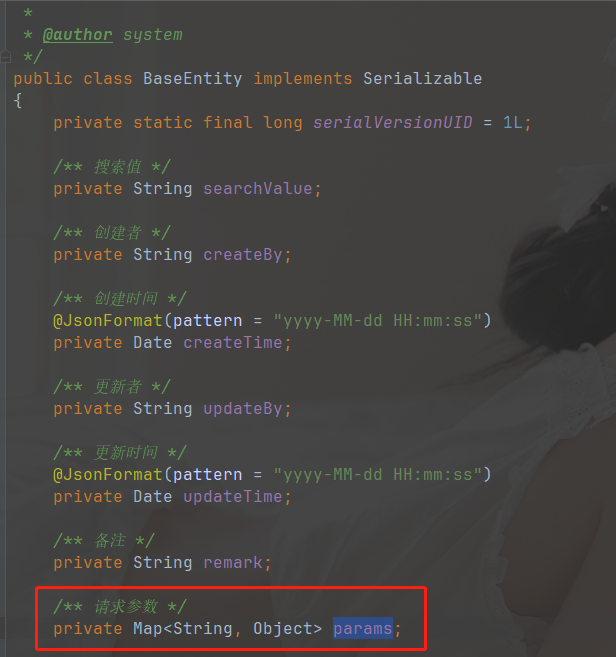一、需求
我们在做项目的时候,通常会根据不同的账号登录进去,展示的菜单和列表不同,这是因为我们在后端根据定义的角色权限,来筛选不同的数据。我们来看看我们Before和After是如何做的。
二、Before
在以前我发现项目中是通过数据库来控制权限的。例如现在有这样的需求不同的账号根据部门权限,看到指定部门权限的数据。
1、通过Controller查询当前账户所在部门及其下属部门,传入mybaits,进行筛选
@RequiresPermissions("facility:plan:list")
@PostMapping("/list")
@ResponseBody
public TableDataInfo list(Plan plan) {
// 查询当前账户所在部门及其下属部门
SysUser sysUser = ShiroUtils.getSysUser();
long deptId = sysUser.getDeptId()==101? 100:sysUser.getDeptId();
SysDept dept = deptService.selectDeptById(deptId);
List<SysDept> deptList = deptService.selectChildrenDeptById(deptId);
deptList.add(dept);
startPage();
List<Plan> list = planService.selectPlanList(plan,deptList);
return getDataTable(list);
}
2、通过sql语句将部门id作为参数,来过滤数据
<select id="selectPlanList" parameterType="Plan" resultMap="PlanResult">
<include refid="selectPlanVo"/>
<where>
<if test="plan.name != null and plan.name != '' "> and name like #{plan.name}</if>
and unitId in
<foreach collection="deptList" item="dept" index="index" open="(" close=")" separator=",">
#{dept.deptId}
</foreach>
</where>
</select>
三、After
通过上面我们会发现,在每一个需要用到部门权限的地方,都要去数据库查一下,然后在用到的地方进行过滤,这不仅增加数据库的访问次数,还会带来代码上的冗余。
1、自定义注解@DataScope,参数中传入关联部门表的别名
/**
* 查询车辆列表
*
* @param optCar 车辆档案
* @return
*/
@Override
@DataScope(deptAlias = "d")
public List<OptCar> selectCarList(OptCar optCar)
{
return optCarMapper.selectCarList(optCar);
}
2、定义的实体类中需要继承BaseEntity,因为需要传入 params 参数。
@Data
public class OptCar extends BaseEntity {
private static final long serialVersionUID = 1L;
/** 主键 */
private Integer id;
/** 车辆编号 */
@Excel(name = "车辆编号")
private String carCode;
/** 车牌号 */
@Excel(name = "车牌号")
private String carNum;
/** 车辆类型 */
@Excel(name = "车辆类型")
private String carType;
/** 地址 */
@Excel(name = "地址")
private String address;
/** 负责人id */
private Integer userId;
/** 负责人名称 */
@Excel(name = "负责人名称")
private String userName;
/** 负责人电话 */
@Excel(name = "负责人电话")
private String phone;
/** 组织id */
private Integer unitId;
/** 组织name */
private String deptName;
/** 经度 */
private String lng;
/** 纬度 */
private String lat;
/**保险到期日*/
@JsonFormat(pattern = "yyyy-MM-dd")
private String insureTime; // 保险到期日
/**年检到期日*/
@JsonFormat(pattern = "yyyy-MM-dd")
private String checkTime; // 年检到期日
/**保险公司名*/
private String insureCompany; // 保险公司名
/**保险公司号码*/
private String insureNum; // 保险公司号码
private String objectId;
}

3、Mybatis进行查询时,关联部门表,并取别名和注解传入的参数相同。然后在where子句中传入param.dataScope参数
<select id="selectCarList" resultType="com.dne.operation.car.domain.OptCar">
SELECT a.id as id,
a.car_code as carCode,
a.car_num as carNum,
a.car_type as carType,
a.address as address,
a.user_id as userId,
a.user_name as userName,
a.phone as phone,
a.unit_id as unitId,
a.lng as lng,
a.lat as lat,
a.insureTime as insureTime,
a.checkTime as checkTime,
a.insureCompany as insureCompany,
a.insureNum as insureNum,
a.object_id as object,
d.dept_name as deptName
FROM op_car a LEFT JOIN sys_dept d ON a.unit_id = d.dept_id
<where>
<if test="id != null"> AND id = #{optCar.id}</if>
<if test="carCode != null and carCode != ''"> AND a.car_code LIKE CONCAT('%',#{carCode},'%')</if>
<if test="carNum != null and carNum != ''"> AND a.car_num LIKE CONCAT('%',#{carNum},'%')</if>
<if test="carType != null and carType != ''"> AND a.car_type = #{carType}</if>
<if test="address != null and address != ''"> AND a.address = #{address}</if>
<if test="userId != null and userId != ''"> AND a.user_id = #{userId}</if>
<if test="userName != null and userName != ''"> AND a.user_name = #{userName}</if>
<if test="phone != null and phone != ''"> AND a.phone = #{phone}</if>
<if test="lng != null and lng != ''"> AND a.lng = #{lng}</if>
<if test="lat != null and lat != ''"> AND a.lat = #{lat}</if>
<if test="insureTime != null and insureTime != ''"> AND a.insureTime = #{insureTime}</if>
<if test="checkTime != null and checkTime != ''"> AND a.checkTime = #{checkTime}</if>
<if test="insureCompany != null and insureCompany != ''"> AND a.insureCompany = #{insureCompany}</if>
<if test="insureNum != null and insureNum != ''"> AND a.insureNum = #{insureNum}</if>
<!-- 数据范围过滤 -->
${params.dataScope}
</where>
</select>
四、@DataScope注解详解
我们来点开@DataScope,可以看到他的参数有部门表的别名、用户表的别名、权限字符。当然权限字符我们可以通过其他注解来控制,这里就不说了。
/**
* 数据权限过滤注解
*
* @author system
*/
@Target(ElementType.METHOD)
@Retention(RetentionPolicy.RUNTIME)
@Documented
public @interface DataScope
{
/**
* 部门表的别名
*/
public String deptAlias() default "";
/**
* 用户表的别名
*/
public String userAlias() default "";
/**
* 权限字符(用于多个角色匹配符合要求的权限)默认根据权限注解@RequiresPermissions获取,多个权限用逗号分隔开来
*/
public String permission() default "";
}
DataScope底层是通过aop来实现的
/**
* 数据过滤处理
*
* @author system
*/
@Aspect
@Component
public class DataScopeAspect
{
/**
* 全部数据权限
*/
public static final String DATA_SCOPE_ALL = "1";
/**
* 自定数据权限
*/
public static final String DATA_SCOPE_CUSTOM = "2";
/**
* 部门数据权限
*/
public static final String DATA_SCOPE_DEPT = "3";
/**
* 部门及以下数据权限
*/
public static final String DATA_SCOPE_DEPT_AND_CHILD = "4";
/**
* 仅本人数据权限
*/
public static final String DATA_SCOPE_SELF = "5";
/**
* 数据权限过滤关键字
*/
public static final String DATA_SCOPE = "dataScope";
@Before("@annotation(controllerDataScope)")
public void doBefore(JoinPoint point, DataScope controllerDataScope) throws Throwable
{
clearDataScope(point);
handleDataScope(point, controllerDataScope);
}
protected void handleDataScope(final JoinPoint joinPoint, DataScope controllerDataScope)
{
// 获取当前的用户
LoginUser loginUser = SecurityUtils.getLoginUser();
if (StringUtils.isNotNull(loginUser))
{
SysUser currentUser = loginUser.getSysUser();
// 如果是超级管理员,则不过滤数据
if (StringUtils.isNotNull(currentUser) && !currentUser.isAdmin())
{
String permission = StringUtils.defaultIfEmpty(controllerDataScope.permission(), SecurityContextHolder.getPermission());
dataScopeFilter(joinPoint, currentUser, controllerDataScope.deptAlias(),
controllerDataScope.userAlias(), permission);
}
}
}
/**
* 数据范围过滤
*
* @param joinPoint 切点
* @param user 用户
* @param deptAlias 部门别名
* @param userAlias 用户别名
* @param permission 权限字符
*/
public static void dataScopeFilter(JoinPoint joinPoint, SysUser user, String deptAlias, String userAlias, String permission)
{
StringBuilder sqlString = new StringBuilder();
List<String> conditions = new ArrayList<String>();
for (SysRole role : user.getRoles())
{
String dataScope = role.getDataScope();
if (!DATA_SCOPE_CUSTOM.equals(dataScope) && conditions.contains(dataScope))
{
continue;
}
if (StringUtils.isNotEmpty(permission) && StringUtils.isNotEmpty(role.getPermissions())
&& !StringUtils.containsAny(role.getPermissions(), Convert.toStrArray(permission)))
{
continue;
}
if (DATA_SCOPE_ALL.equals(dataScope))
{
sqlString = new StringBuilder();
break;
}
else if (DATA_SCOPE_CUSTOM.equals(dataScope))
{
sqlString.append(StringUtils.format(
" OR {}.dept_id IN ( SELECT dept_id FROM sys_role_dept WHERE role_id = {} ) ", deptAlias,
role.getRoleId()));
}
else if (DATA_SCOPE_DEPT.equals(dataScope))
{
sqlString.append(StringUtils.format(" OR {}.dept_id = {} ", deptAlias, user.getDeptId()));
}
else if (DATA_SCOPE_DEPT_AND_CHILD.equals(dataScope))
{
sqlString.append(StringUtils.format(
" OR {}.dept_id IN ( SELECT dept_id FROM sys_dept WHERE dept_id = {} or find_in_set( {} , ancestors ) )",
deptAlias, user.getDeptId(), user.getDeptId()));
}
else if (DATA_SCOPE_SELF.equals(dataScope))
{
if (StringUtils.isNotBlank(userAlias))
{
sqlString.append(StringUtils.format(" OR {}.user_id = {} ", userAlias, user.getUserId()));
}
else
{
// 数据权限为仅本人且没有userAlias别名不查询任何数据
sqlString.append(StringUtils.format(" OR {}.dept_id = 0 ", deptAlias));
}
}
conditions.add(dataScope);
}
if (StringUtils.isNotBlank(sqlString.toString()))
{
Object params = joinPoint.getArgs()[0];
if (StringUtils.isNotNull(params) && params instanceof BaseEntity)
{
BaseEntity baseEntity = (BaseEntity) params;
baseEntity.getParams().put(DATA_SCOPE, " AND (" + sqlString.substring(4) + ")");
}
}
}
/**
* 拼接权限sql前先清空params.dataScope参数防止注入
*/
private void clearDataScope(final JoinPoint joinPoint)
{
Object params = joinPoint.getArgs()[0];
if (StringUtils.isNotNull(params) && params instanceof BaseEntity)
{
BaseEntity baseEntity = (BaseEntity) params;
baseEntity.getParams().put(DATA_SCOPE, "");
}
}
}